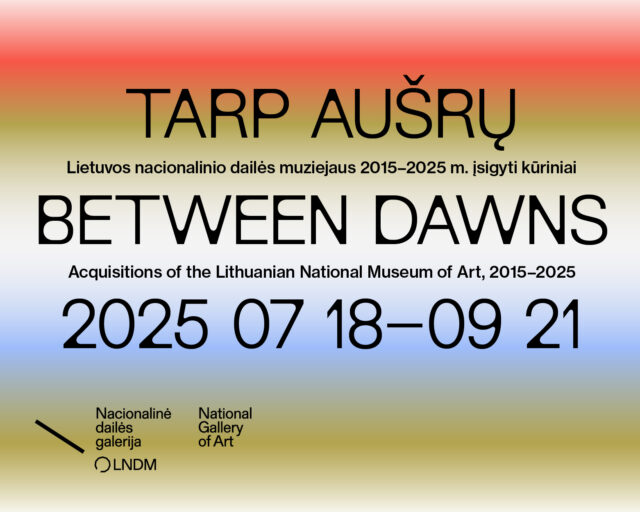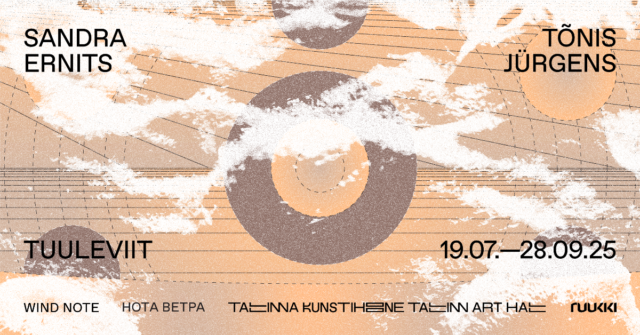It was Paul Gaugin who, despite the conspicuous reality of the ‘lost paradise’, headed in the direction of French Polynesia, and walked the silent Tahiti nights in search of redemption. The scenario of Kaspars Groševs’ and Evita Vasiljeva’s Pacifiction is rather divergent: seeking that ‘don’t-know-where’, ‘don’t-know-what’ in a peripheral city-wildlife a bit closer to home. The exotic associations of the exhibition ‘The Blue Lagoon House’, borrowed from a 1984 drawing of the first Latvian artistic director of everything, Hardijs Lediņš, serves here as an indicator of the ephemeral. The exhibition is buzzing with the elusiveness of a collective spirit, the intangibility of a performative artwork, the fading of instantaneous spaces, and extraordinary circumstances, unfolding in a half-curated, half-improvised manner, when living in the urban tropics known as the artistic community.
This is hardly the first time Kaspars and Evita meet in the same exhibition site. While both Latvian artists work in a rather distinct manner, they sit as well together as two peas in a pod. We could refer to Groševs as ‘a jack of all trades’, with a fondness for hazy, pulsating, magenta-reddish paintings, often revealing the emotional fragility and simmeringly ethereal melancholia of characters. Vasiljeva is a virtuoso ‘powerlifter’, with a fine skill to lightly master surprisingly heavy materials. Hence, she creates architectural, harmonious, nearly queer-character structures, with pure strength and masculinity in the framework, and nuanced femininity and delicacy in the details. In this exhibition, the artists undoubtedly share a mutual understanding, but they also maintain their authenticity, co-existing, so to speak, as symbiotically as Sea Anemone and Clownfish, while overlapping only contextually.
Flashing back to the artists’ Exquisite Corpse style collaboration in 2019 at Kim? Contemporary Art Centre, the group show A Very Small Window[1] attracted some fault-finding comments for being ‘interesting only to the artists themselves’.[2] Certainly, the playful twists and crochets of the Kim? exhibition, even if witty and entertaining, at times turned out to be accessible to a very closed group of people. However, for this show, Vasiljeva and Groševs have pushed further the quests within the collective spirit, while not giving up what they find appealing themselves. This time, with the supporting beam of vivid references to NSRD,[3] and some moderate conceptual bulletproofing around the term ‘approximate art’, they have dodged disciplinary boundaries and divisions quite eloquently.

Installation view
‘The Blue Lagoon House’ is an ambitious three-floor installation, ranging thoughout the Cēsis Contemporary Art Centre. The first floor draws the visitor into something that has the aura of a local-knowledge party place. It seems like the floor plan is not accidental. Each object glowing in the moody lighting unfolds as a significant symbol of underground culture, and narrates the viewer towards the central piece, the Lagoon kiosk. On their way, visitors pass a poster wall by an unknown author revealing captivating local events, Vasiljeva’s glowering soap lanterns fused with dead flies, and Groševs’ paintings of folklorised community members, such as the Bolderāja bookstore-bar owner Didzis, and Madona’s drowned punk. Further, NSRD-reminiscent sounds lead to the video work On the Way to Bolderāja, featuring fiery, sweaty-air events at hidden wonder spots, the Bolderāja bookstore-bar, the Auss bar, the 427 gallery, the Serviss club, the 1983 bar, and the Lagoon kiosk in Riga at 19/21 Vagonu St. Finally arriving at the apex, we meet an artwork that visually synopsises the artist’s statement of Groševs’ entire oeuvre. The essence of Kaspars Groševs’ work is the community he curates around his interdisciplinary practice.
The Lagoon kiosk at Cēsis is an iteration of the same kiosk featured in the video, reminiscent of a distantly edgy version of the white cube, hosting raw art and electronic sound events at the end of the summer of 2021 in Riga. A number of artists took over the place at that time, each adding an artwork to a permanent exhibition, and later celebrated it with a tiny rave. The outcome, soaked in performative happenings and thickened with multiple layers, was brought to Cēsis. By including emerging and already-established artists in the kiosk, Groševs made a magic mantle for those still outside the institutional spotlight, and brought forth some interesting new names, like Anna Malicka and Dzelde Mierkalna. If one was lucky enough to experience the show during the opening and finissage events, one caught sight of the inhabitants of the Blue Lagoon House in action. The local phyto-plankton was luminescent and bouncing with the beat of quality techno by local underground names, Smiltis, Bobijs Velns, Labais Dāma and Otra Pussyte, in the oasis of Eastern Europe’s periphery.
To be frank, it is difficult to find something that Kaspars Groševs cannot do. Curating, painting, writing, experimenting with sound art, he is truly a ‘jack of all trades’, and often far better than a ‘master of one’. A distressingly patent fact is that one could easily link Groševs with the late ‘Latvian multimedia patriarch’ Hardijs Lediņš himself. The ironic twist is that besides the spotlight of the Cēsis Art Festival in recent years, followed up since his gesamtkunstwerk, the Different Room[4] in 2020, Groševs rather bends towards the underratedness of Lediņš was in his time, quietly working on his practice, curating underground events, and running Riga’s contemporary art gem, the gallery 427. While The Blue Lagoon House is an artists’ ode to the community, it has also accidentally turned out to be an uncomfortably prophetic invitation for reconsideration, addressed to the blindfolded local scene, waving from the not-so-long-ago past: how many generations of groundbreakers should we ignore?
In front of the curtain is the concept of a micro-utopia, as well as Lediņš’ drawing The Blue Lagoon House, the tipping point around which everything else gravitates. Any kind of Utopia is located ‘on the horizon’: it moves away as you move closer. The second floor is a visual representation of this for ever away-moving bliss. The space, compared to the ground floor, has a light, clean and almost feathery atmosphere. Evita Vasiljeva’s concrete Bells refers to easily crumbling sandcastles, and the inevitable fading of everything. Together with the glowing sunsets of the painting-like Little Soap Operas, it recalls a carefree evening by the beach, with a melting ice cream running down the arm. To avoid this particular misfortune from happening, Vasiljeva has cast the ice cream in concrete. Vasiljeva’s sunset tones echo in Groševs’ flaming paintings, creating a cryptic but hypotonic landscape. The windows with floating curtains bring a light breeziness into the space, which matches Kamil Bouzoubaa-Grivel’s wind vanes on the rooftop, Don-Quixote’s Windmills, continuing the everlasting fight and distorting the role of the protagonist. The top floors certainly complement the overall feeling of a perpetual abstract inner struggle, but ease it with light reconciliation, possibly something that one feels while gazing at the sun setting over the sea.

Installation view
Beware of the purple haze. The tones of magenta-red and flaming-orange of Groševs’ paintings pulsate as vibrantly as Evita’s sunset-coloured soap lamps. The air in the paintings is seemingly thick with cigarette smoke, which alone draws quite an ambience. In addition, the surreal, nightmarish characters from Groševs’ series S.W.I.M. (Someone Who Isn’t Me) resembles those who usually move through shabby, dimly lit bars as slowly and goal-driven as somnambulists. These details on a plainly intuitive level inform the viewer of the bohemian idyll that might turn out to be far from paradise. Characters burdened with complexities seep through the veil of hedonism: depression, financial difficulties, routine intoxication, and health problems triggered by burn-out, in fact, hint that the hotspot of happenings might just be the epicentre of loneliness. Some of these portrayed members have tender-hearted facial expressions, despite the profound undertone of sadness. Thus, at times, the floating island is miraging out on the horizon. This layer is not the focus of the exhibition, but it is by no means absent.
The intertwining feeling is that of ephemeral, disappearing gestures akin to anticipatory nostalgia about times that have not yet passed, or perhaps longing for some rapturous delight, a frenzy of poetic inspiration, or just something that has yet to be named. The long-time co-curators of the main exhibition at the Cēsis Art Festival, Daiga Rudzāte and Žanete Skarule, seemingly took a curatorial bow out this year, by passing the torch to Groševs and Vasiljeva with absolute trust. The artists achieved their full ambitions in a seamless tandem. Placing the building in the hands of the artists turned it into a genuine living organism, and made the ‘artist’s presence’ in the installation raw and sensible. In contrast with the preceding year’s feedback of the ‘tired festival’,[5] this year’s exhibition, without exaggerating, has the most clarity of form, arranging an exclusive, untamed contemporary experience of authentic artistic expression.

Evita Vasiljeva. Little Soap Opera I-VI. 2022. Soap, fiels, pigments, thread

Installation view

Installation view

Installation view
[1] The group show A Very Small Window. Kim? Contemporary Art Centre, 2019. Available: https://kim.lv/en/group-show-small-window/
[2] Hirša S. Lodziņš bez patskaņiem un līdzskaņiem. Diena, 2019. Available: https://www.diena.lv/raksts/kd/recenzijas/izstades-_loti-mazs-lodzins_-recenzija.-lodzins-bez-patskaniem-un-lidzskaniem-14223895
[3] NSRD (Restoration of Unfelt Feelings) is a Riga-based collective workshop created by Hardijs Lediņš and Juris Boiko, which operated from the end of the 1970s until 1989.
[4] Different Room by Kaspar Grosevs at the Cēsis Art Festival 2020. Available: https://kasprsg.com/?different
[5] Hirša, S. Festivāls ir noguris. LSM, 2019. Available: https://www.lsm.lv/raksts/kultura/maksla/festivals-ir-noguris-recenzija-par-izstadem-koncertzale-cesis-makslas-festivala-ietvaros.a328277/






























